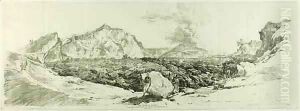John Auldjo Paintings
John Auldjo, also known as John Richardson Auldjo, was a British geologist, travel writer, and artist, born on August 26, 1805, in Montreal, Canada. Though not primarily known for his artistic endeavors, Auldjo made significant contributions to the fields of geology and travel literature, which were often supplemented with his sketches and drawings.
Auldjo attended Trinity College, Cambridge, where he graduated in 1827. His strong interest in geology led him to become an active member of the Geological Society of London, and in 1830 he published 'A Description of the Glacieres or Ice Alps in Savoy, in Two Letters, One from an English Gentleman to His Friend at Geneva; the Other from Peter Martel, Engineer, to the Former'. This work, which included detailed illustrations and mapped the complex terrain of the glaciers, was one of the first English texts on the subject and helped to popularize Alpine climbing.
In 1834, Auldjo climbed Mont Blanc, and subsequently, he published 'Narrative of an Ascent to the Summit of Mont Blanc'. His written account was accompanied by lithographic illustrations based on his drawings, showcasing both his writing and artistic skills. Auldjo’s experiences and observations contributed to the early understanding of high-altitude physiology and mountaineering.
Although Auldjo did not achieve fame as a painter or sculptor, his illustrations and sketches serve as a visual account of his scientific and adventurous pursuits. His work is valuable for its contribution to early 19th-century scientific literature and as a representation of the intersections between science, art, and travel during that period.
After his adventures in the Alps, Auldjo traveled extensively, including to Naples, where he studied volcanic activity. His interest in volcanology was significant enough that mineral auldjite was named after him. He eventually settled down in England and continued to engage with the scientific community until his death on April 26, 1886. John Auldjo's legacy lies in his eclectic contributions to geology, his travel writings, and the sketches that brought his observations to a wider audience.
